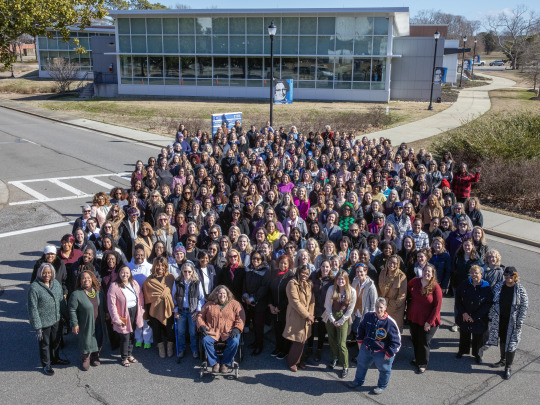#nasa langley research center
Text

"The HL-20 was built at Langley in October 1990 and is a full-scale non-flying mockup. This mockup was used for engineering studies of maintainability of the vehicle, as testing crew positions, pilot visibility and other human factors considerations. The HL-20 was a direct derivative of the HL-10 vehicle tested in the 1960s and bears a very close resemblance to engineering drawings produced at that time. Although evaluated as a possible 'space taxi,' the HL-20, sometimes called the 'Personnel Launch System,' was never built."
Date: October 22, 1991
NASA ID: L-1991-14834
#HL-20 Personnel Launch System#HL-20#Lifting Body#Space Taxi#Spaceplane#NASA#Langley Research Center#Hampton#Virginia#Mock-Up#Mock Up#Mockup#October#1991#my post
64 notes
·
View notes
Photo
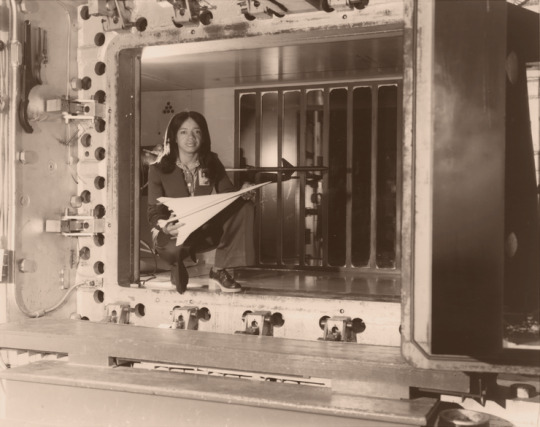
Aeronautical engineer Christine Darden, NASA Langley Research Center, Hampton, Virginia, 1976.
#science#aeronautics#engineering#Christine Darden#NASA#Langley Research Center#Hampton#Virginia#USA#1976
164 notes
·
View notes
Video
youtube
NASA's Unpressurized Lunar Lander
#youtube#Langley Research Center Unpressurized Crew Transport#what if#nasa#LOX#short stay#LH2#luna lander#realistic spaceships
16 notes
·
View notes
Photo
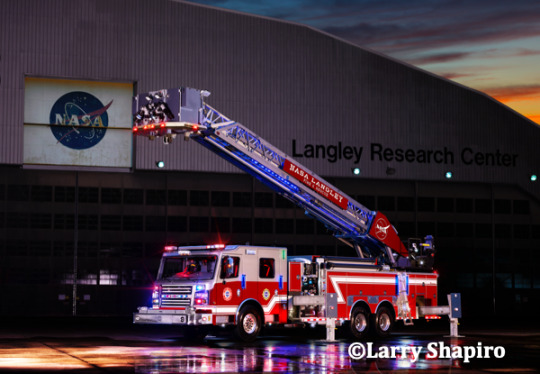
NASA Langley Research Center Fire Department
#larryshapiro#Larry Shapiro#Shapirophotography.net#Larryshapiro.tumblr.com#larryshapiroblog.com#FireTruck#rosenbaueramerica#Rosenbauer#Commander#Cobra#NASA#NASALangley#NASA Langley Research Center FD#night photography
5 notes
·
View notes
Text
NASA Selects Langley Research Center Support Contractor
NASA has awarded the Center, Operations Maintenance, and Engineering II contract to Jacobs Technology Inc. of Tullahoma, Tennessee, to support operations at the agency’s Langley Research Center in Hampton, Virginia. The contract is a cost-plus-fixed-fee indefinite-delivery/indefinite-quantity contract with a maximum potential value of $973.7 million. Following a phase-in period that starts Tuesday, Oct. 1 and […]
from NASA https://ift.tt/X0AW6pe
0 notes
Text
Athletes Go for the Gold with NASA Spinoffs
NASA technology tends to find its way into the sporting world more often than you’d expect. Fitness is important to the space program because astronauts must undergo the extreme g-forces of getting into space and endure the long-term effects of weightlessness on the human body. The agency’s engineering expertise also means that items like shoes and swimsuits can be improved with NASA know-how.
As the 2024 Olympics are in full swing in Paris, here are some of the many NASA-derived technologies that have helped competitive athletes train for the games and made sure they’re properly equipped to win.
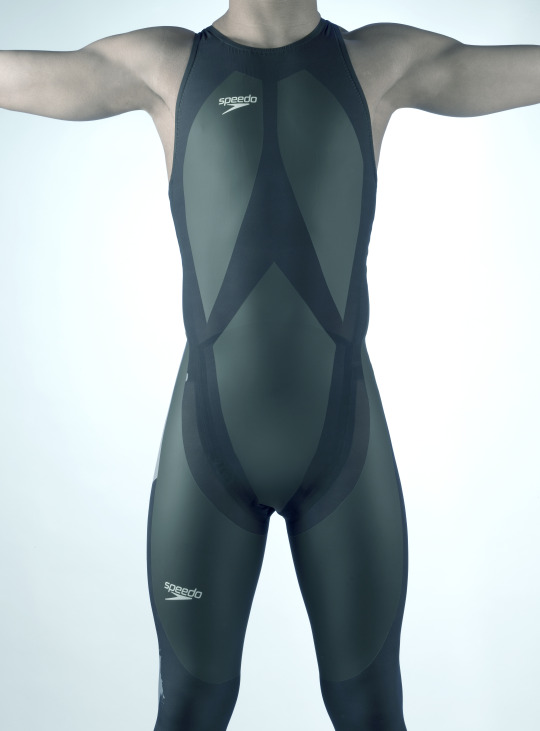
The LZR Racer reduces skin friction drag by covering more skin than traditional swimsuits. Multiple pieces of the water-resistant and extremely lightweight LZR Pulse fabric connect at ultrasonically welded seams and incorporate extremely low-profile zippers to keep viscous drag to a minimum.
Swimsuits That Don’t Drag
When the swimsuit manufacturer Speedo wanted its LZR Racer suit to have as little drag as possible, the company turned to the experts at Langley Research Center to test its materials and design. The end result was that the new suit reduced drag by 24 percent compared to the prior generation of Speedo racing suit and broke 13 world records in 2008. While the original LZR Racer is no longer used in competition due to the advantage it gave wearers, its legacy lives on in derivatives still produced to this day.

Trilion Quality Systems worked with NASA’s Glenn Research Center to adapt existing stereo photogrammetry software to work with high-speed cameras. Now the company sells the package widely, and it is used to analyze stress and strain in everything from knee implants to running shoes and more.
High-Speed Cameras for High-Speed Shoes
After space shuttle Columbia, investigators needed to see how materials reacted during recreation tests with high-speed cameras, which involved working with industry to create a system that could analyze footage filmed at 30,000 frames per second. Engineers at Adidas used this system to analyze the behavior of Olympic marathoners' feet as they hit the ground and adjusted the design of the company’s high-performance footwear based on these observations.

Martial artist Barry French holds an Impax Body Shield while former European middle-weight kickboxing champion Daryl Tyler delivers an explosive jump side kick; the force of the impact is registered precisely and shown on the display panel of the electronic box French is wearing on his belt.
One-Thousandth-of-an-Inch Punch
In the 1980s, Olympic martial artists needed a way to measure the impact of their strikes to improve training for competition. Impulse Technology reached out to Glenn Research Center to create the Impax sensor, an ultra-thin film sensor which creates a small amount of voltage when struck. The more force applied, the more voltage it generates, enabling a computerized display to show how powerful a punch or kick was.

Astronaut Sunita Williams poses while using the Interim Resistive Exercise Device on the ISS. The cylinders at the base of each side house the SpiraFlex FlexPacks that inventor Paul Francis honed under NASA contracts. They would go on to power the Bowflex Revolution and other commercial exercise equipment.
Weight Training Without the Weight
Astronauts spending long periods of time in space needed a way to maintain muscle mass without the effect of gravity, but lifting free weights doesn’t work when you’re practically weightless. An exercise machine that uses elastic resistance to provide the same benefits as weightlifting went to the space station in the year 2000. That resistance technology was commercialized into the Bowflex Revolution home exercise equipment shortly afterwards.
Want to learn more about technologies made for space and used on Earth? Check out NASA Spinoff to find products and services that wouldn’t exist without space exploration.
Make sure to follow us on Tumblr for your regular dose of space!
2K notes
·
View notes
Text

The transonic wind tunnel at NASA’s Langley Research Center, Virginia, built in 1939. Photo by Bill Taub.
284 notes
·
View notes
Photo
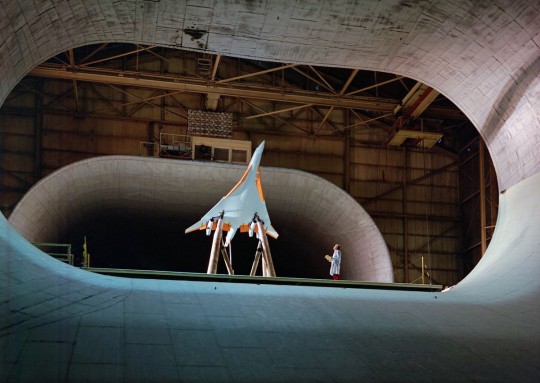
A wind-tunnel model of a supersonic transport undergoing testing at NASA Langley Research Center on January 17, 1975
298 notes
·
View notes
Text


There is nothing that amuses me more than a secret inside of a secret.
Here’s an article that I wrote that my friend Dario Leone owner of Aviation Geek Club shared about the YF 12 and the secret SR 71 tail number 951.
Most people when they think of the YF 12 think of it as an experimental airplane that never really flew, but that is wrong. It did fly for many years. The last flight was in 1979 when it was flown to the Air Force Museum near Dayton, Ohio you can find it next to the XB-70.
The so-called YF-12C was really the SR-71A 61-7951, modified with a bogus tail number 06937 belonging to an A-12.
Taken in 1975, the interesting photos in this post show NASA Blackbirds carrying the ” Cold wall” heat transfer pod on a pylon beneath the forward fuselage.
The Blackbirds portrayed in these photos are usually referred to as YF-12s, but actually one of them was an SR-71 as Linda Sheffield Miller (Col Richard (Butch) Sheffield’s daughter, Col. Sheffield was an SR-71 Reconnaissance Systems Officer), who runs Born into the Wild Blue Yonder Habubrats Facebook page, told to The Aviation Geek Club: ‘In case anybody asked the pictures with the two NASA Blackbirds the one on the top is a YF-12 but the one on the bottom is an SR-71!
‘Another interesting thing about those pictures is that NASA was not allowed to have an SR-71 but they did and they passed it off as a YF-12!
In fact, the “YF-12C” was a then-secret SR-71A (serial no. 64-17951, the second production SR-71A) given the NASA tail no. 60-6937. The reason for this bit of subterfuge lay in the fact that NASA while flying the YF-12A interceptor version of the aircraft, was not allowed to possess the strategic reconnaissance version for some time. The bogus tail number actually belonged to a Lockheed A-12 (serial no. 60-6937), but the existence of the A-12 remained classified until 1982. The tail number 06937 was selected because it followed the sequence of tail numbers assigned to the three existing YF-12A aircraft: 06934, 06935, and 06936. Isn’t that amazing?’
The Coldwell project, supported by Langley Research Center, consisted of a stainless steel tube equipped with thermocouples and pressure sensors. A special insulating coating covered the tube, which was chilled with liquid nitrogen.
Given that the US Air Force (USAF) needed technical assistance to get the latest reconnaissance version of the A-12 family, the SR-71A, fully operational, the service offered NASA the use of two YF-12A aircraft, 60-6935 and 60-6936.
Eventually, with 146 flights between Dec. 11, 1969, and Nov. 7, 1979, 935 became the workhorse of the program while the second YF-12A, 936, made 62 flights. Given that this aircraft was lost in a non-fatal crash on Jun. 24, 1971, it was replaced by the so-called YF-12C SR-71A 61-7951, modified with YF-12A inlets and engines and a bogus tail number 06937.
The SR-71 differed from the YF-12A in that the YF-12A had a round nose while the SR-71 had its chine carried forward to the nose of the airplane. The SR-71 was longer, nearly 8 feet longer as it had an extra fuel tank that the YF 12 didn’t have. There were other differences in internal and external configuration, but the two aircraft shared common inlet designs, structural concepts, and subsystems. Also of note the SR 71C is really a combination of a static display of the SR 71 for the front half and the back half is the crashed YF-12!
In my study of all the Blackbirds, I have found other secrets inside of secrets. Such as the test SR-71 plane the 955. Everyone was told often that this airplane never left the United States, but that is not true.
When it comes to reconnaissance airplanes and War, even if it was a Cold War, Rearranging the facts is fair.
There will always be mystery in the SR 71 program.
Don’t believe that all of the secrets have been told.
I know that is not true.
Linda Sheffield, Daughter of a Habu
@Habubrats71 via X
Tap Title bar to view👇
42 notes
·
View notes
Text
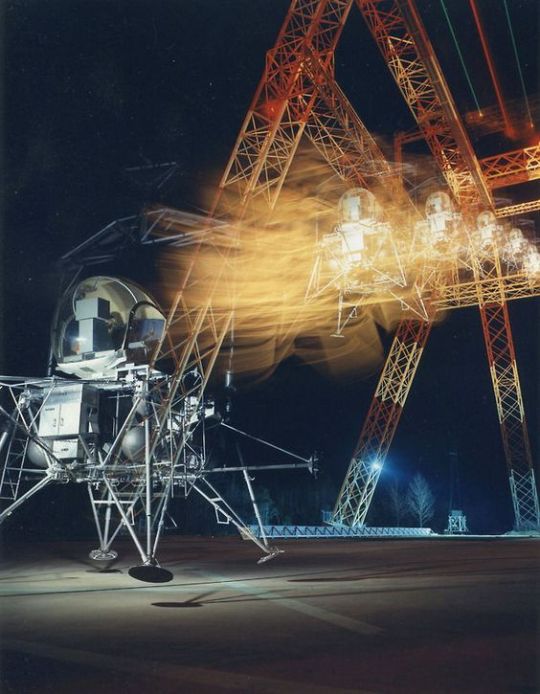
A multiple-exposure image of a lunar module prototype being tested in the Impact Dynamics Research Facility at NASA’s Langley Research Center, 1967
96 notes
·
View notes
Text


Here's how Curiosity's sky crane changed the way NASA explores Mars
Twelve years ago, NASA landed its six-wheeled science lab using a daring new technology that lowers the rover using a robotic jetpack.
NASA's Curiosity rover mission is celebrating a dozen years on the red planet, where the six-wheeled scientist continues to make big discoveries as it inches up the foothills of a Martian mountain. Just landing successfully on Mars is a feat, but the Curiosity mission went several steps further on Aug. 5, 2012, touching down with a bold new technique: the sky crane maneuver.
A swooping robotic jetpack delivered Curiosity to its landing area and lowered it to the surface with nylon ropes, then cut the ropes and flew off to conduct a controlled crash landing safely out of range of the rover.
Of course, all of this was out of view for Curiosity's engineering team, which sat in mission control at NASA's Jet Propulsion Laboratory in Southern California, waiting for seven agonizing minutes before erupting in joy when they got the signal that the rover landed successfully.
The sky crane maneuver was born of necessity: Curiosity was too big and heavy to land as its predecessors had—encased in airbags that bounced across the Martian surface. The technique also added more precision, leading to a smaller landing ellipse.
During the February 2021 landing of Perseverance, NASA's newest Mars rover, the sky crane technology was even more precise: The addition of something called terrain relative navigation enabled the SUV-size rover to touch down safely in an ancient lake bed riddled with rocks and craters.
Evolution of a Mars landing
JPL has been involved in NASA's Mars landings since 1976, when the lab worked with the agency's Langley Research Center in Hampton, Virginia, on the two stationary Viking landers, which touched down using expensive, throttled descent engines.
For the 1997 landing of the Mars Pathfinder mission, JPL proposed something new: As the lander dangled from a parachute, a cluster of giant airbags would inflate around it. Then three retrorockets halfway between the airbags and the parachute would bring the spacecraft to a halt above the surface, and the airbag-encased spacecraft would drop roughly 66 feet (20 meters) down to Mars, bouncing numerous times—sometimes as high as 50 feet (15 meters)—before coming to rest.
It worked so well that NASA used the same technique to land the Spirit and Opportunity rovers in 2004. But that time, there were only a few locations on Mars where engineers felt confident the spacecraft wouldn't encounter a landscape feature that could puncture the airbags or send the bundle rolling uncontrollably downhill.
"We barely found three places on Mars that we could safely consider," said JPL's Al Chen, who had critical roles on the entry, descent, and landing teams for both Curiosity and Perseverance.
It also became clear that airbags simply weren't feasible for a rover as big and heavy as Curiosity. If NASA wanted to land bigger spacecraft in more scientifically exciting locations, better technology was needed.
Rover on a rope
In early 2000, engineers began playing with the concept of a "smart" landing system. New kinds of radars had become available to provide real-time velocity readings—information that could help spacecraft control their descent. A new type of engine could be used to nudge the spacecraft toward specific locations or even provide some lift, directing it away from a hazard. The sky crane maneuver was taking shape.
JPL Fellow Rob Manning worked on the initial concept in February 2000, and he remembers the reception it got when people saw that it put the jetpack above the rover rather than below it.
"People were confused by that," he said. "They assumed propulsion would always be below you, like you see in old science fiction with a rocket touching down on a planet."
Manning and colleagues wanted to put as much distance as possible between the ground and those thrusters. Besides stirring up debris, a lander's thrusters could dig a hole that a rover wouldn't be able to drive out of. And while past missions had used a lander that housed the rovers and extended a ramp for them to roll down, putting thrusters above the rover meant its wheels could touch down directly on the surface, effectively acting as landing gear and saving the extra weight of bringing along a landing platform.
But engineers were unsure how to suspend a large rover from ropes without it swinging uncontrollably. Looking at how the problem had been solved for huge cargo helicopters on Earth (called sky cranes), they realized Curiosity's jetpack needed to be able to sense the swinging and control it.
"All of that new technology gives you a fighting chance to get to the right place on the surface," said Chen.
Best of all, the concept could be repurposed for larger spacecraft—not only on Mars, but elsewhere in the solar system. "In the future, if you wanted a payload delivery service, you could easily use that architecture to lower to the surface of the moon or elsewhere without ever touching the ground," said Manning.
TOP IMAGE: This artist’s concept shows how NASA’s Curiosity Mars rover was lowered to the planet’s surface using the sky crane maneuver. Credit: NASA/JPL-Caltech
LOWER IMAGE: The rocket-powered descent stage that lowered NASA’s Curiosity onto the Martian surface is guided over the rover by technicians at the agency’s Kennedy Space Center in September 2011, two months before the mission’s launch. Credit: NASA/Kim Shiflett
8 notes
·
View notes
Text
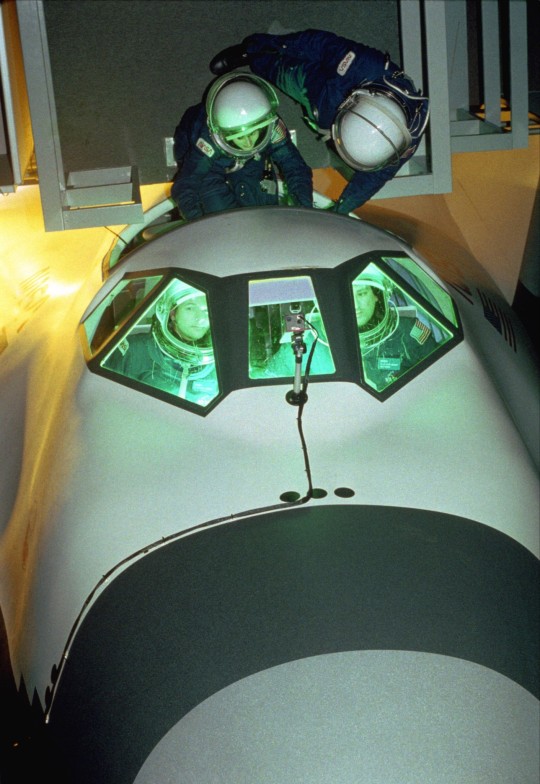
"The HL-20 space taxi, Langley's candidate personnel launch system, is one of several designs being considered by NASA as a complement to the Space Shuttle. Human factors studies, using Langley volunteers as subjects, have been ongoing since March 1991 to verify crew seating arrangements, habitability, ingress and egress, equipment layout and maintenance and handling operations, and to determine visibility requirements during docking and landing operations. Langley volunteers, wearing flight suits and helmets, were put through a series of tests with the craft placed both vertically and horizontally to simulate launch and landing attitudes, The HL-20 would be launched into a low orbit by an expendable rocket and then use its own propulsion system to boost itself to the space station. Following exchange of crews or delivery of small payload, the HL-20 would return to Earth like the space shuttle, making a runway landing near the launch site, The full-scale engineering research model of the HL-20 design was constructed by students and faculty at North Carolina State University and North Carolina A&T State University with the Mars Mission Research Center under a grant from NASA Langley."
Date: January 22, 1992
NASA ID: EL-1996-00163
#HL-20 Personnel Launch System#HL-20#Lifting Body#Space Taxi#Spaceplane#NASA#Langley Research Center#Hampton#Virginia#Mock-Up#Mock Up#Mockup#January#1992#my post
30 notes
·
View notes
Text
writers, what niche thing have you been researching for your work lately? i'm currently reading the 1998 research highlights from NASA's Langley Research Center
#i love how they have all their past research highlights online#for my weirdly specific character who works there in the 90s#they list one of their missions as “discover mysteries of the universe” space exploration is so cute#chrissy.txt#writing
11 notes
·
View notes
Text

Art by @nettiebeatrice
Women's History Month
Mary McLeod Bethune was an African American educator, philanthropist, humanitarian, womanist, and civil rights activist. She founded the National Council of Negro Women in 1935, established the org's flagship journal, and led a myriad of African American women's organizations.

Katherine Johnson was an African American mathematician whose calculations of orbital mechanics as a NASA employee were critical to the success of the first and subsequent US crewed spaceflights. The space agency noted her "historical role as one of the first African-American women to work as a NASA scientist"

Dorothy Jean Johnson Vaughan was an American mathematician and human computer who worked for the National Advisory Committee for Aeronautics, and NASA, at Langley Research Center in Hampton, Virginia.

Hattie McDaniel was an American actress, singer-songwriter, and comedienne. She won the Academy Award for Best Supporting Actress, becoming the first African American to win an Oscar.

On Sept. 12, 1992, Mae Jemison boarded the space shuttle "Endeavor" and with six other astronauts, orbited the earth. Her trip to the stars landed Jemison in the history books as the first Black woman in space.

Harriet Tubman was an American abolitionist and social activist. After escaping slavery, Tubman made some 13 missions to rescue approximately 70 enslaved people, including her family and friends, using the network of antislavery activists and safe houses known collectively as the Underground Railroad.

Frida Kahlo was a Mexican artist who explored pain, adversity, resilience, and cultural and political conflict through her paintings. Kahlo is known for her uncompromising, vivid self-portraits of all she endured during her lifetime.

Margaret Taylor-Burroughs, an American visual artist, writer, poet, educator, and arts organizer. She co-founded the DuSable Museum of African American History in Chicago.
9 notes
·
View notes
Text

LaRue Burbank, mathematician and computer, is just one of the many women who were instrumental to NASA missions.
4 Little Known Women Who Made Huge Contributions to NASA
Women have always played a significant role at NASA and its predecessor NACA, although for much of the agency’s history, they received neither the praise nor recognition that their contributions deserved. To celebrate Women’s History Month – and properly highlight some of the little-known women-led accomplishments of NASA’s early history – our archivists gathered the stories of four women whose work was critical to NASA’s success and paved the way for future generations.
LaRue Burbank: One of the Women Who Helped Land a Man on the Moon
LaRue Burbank was a trailblazing mathematician at NASA. Hired in 1954 at Langley Memorial Aeronautical Laboratory (now NASA’s Langley Research Center), she, like many other young women at NACA, the predecessor to NASA, had a bachelor's degree in mathematics. But unlike most, she also had a physics degree. For the next four years, she worked as a "human computer," conducting complex data analyses for engineers using calculators, slide rules, and other instruments. After NASA's founding, she continued this vital work for Project Mercury.
In 1962, she transferred to the newly established Manned Spacecraft Center (now NASA’s Johnson Space Center) in Houston, becoming one of the few female professionals and managers there. Her expertise in electronics engineering led her to develop critical display systems used by flight controllers in Mission Control to monitor spacecraft during missions. Her work on the Apollo missions was vital to achieving President Kennedy's goal of landing a man on the Moon.
Eilene Galloway: How NASA became… NASA
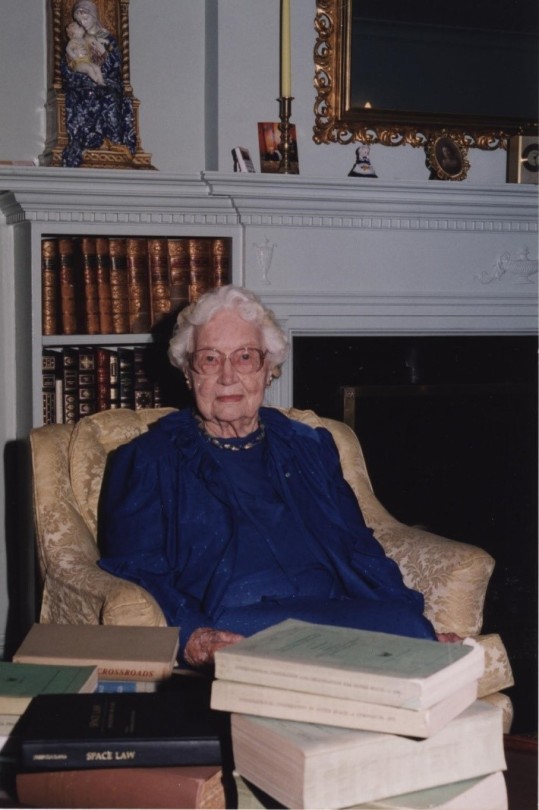
Eilene Galloway wasn't a NASA employee, but she played a huge role in its very creation. In 1957, after the Soviet Union launched Sputnik, Senator Richard Russell Jr. called on Galloway, an expert on the Atomic Energy Act, to write a report on the U.S. response to the space race. Initially, legislators aimed to essentially re-write the Atomic Energy Act to handle the U.S. space goals. However, Galloway argued that the existing military framework wouldn't suffice – a new agency was needed to oversee both military and civilian aspects of space exploration. This included not just defense, but also meteorology, communications, and international cooperation.
Her work on the National Aeronautics and Space Act ensured NASA had the power to accomplish all these goals, without limitations from the Department of Defense or restrictions on international agreements. Galloway is even to thank for the name "National Aeronautics and Space Administration", as initially NASA was to be called “National Aeronautics and Space Agency” which was deemed to not carry enough weight and status for the wide-ranging role that NASA was to fill.
Barbara Scott: The “Star Trek Nerd” Who Led Our Understanding of the Stars
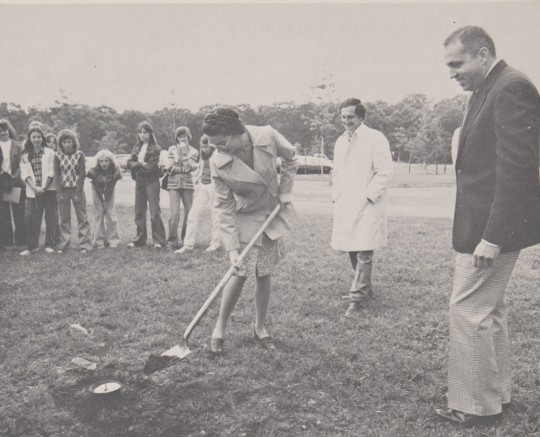
A self-described "Star Trek nerd," Barbara Scott's passion for space wasn't steered toward engineering by her guidance counselor. But that didn't stop her! Fueled by her love of math and computer science, she landed at Goddard Spaceflight Center in 1977. One of the first women working on flight software, Barbara's coding skills became instrumental on missions like the International Ultraviolet Explorer (IUE) and the Thermal Canister Experiment on the Space Shuttle's STS-3. For the final decade of her impressive career, Scott managed the flight software for the iconic Hubble Space Telescope, a testament to her dedication to space exploration.
Dr. Claire Parkinson: An Early Pioneer in Climate Science Whose Work is Still Saving Lives
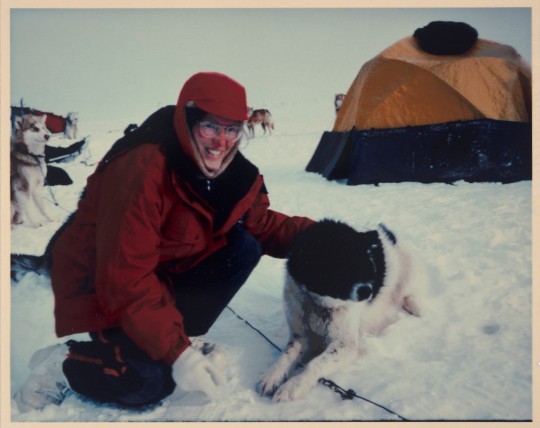
Dr. Claire Parkinson's love of math blossomed into a passion for climate science. Inspired by the Moon landing, and the fight for civil rights, she pursued a graduate degree in climatology. In 1978, her talents landed her at Goddard, where she continued her research on sea ice modeling. But Parkinson's impact goes beyond theory. She began analyzing satellite data, leading to a groundbreaking discovery: a decline in Arctic sea ice coverage between 1973 and 1987. This critical finding caught the attention of Senator Al Gore, highlighting the urgency of climate change.
Parkinson's leadership extended beyond research. As Project Scientist for the Aqua satellite, she championed making its data freely available. This real-time information has benefitted countless projects, from wildfire management to weather forecasting, even aiding in monitoring the COVID-19 pandemic. Parkinson's dedication to understanding sea ice patterns and the impact of climate change continues to be a valuable resource for our planet.
Make sure to follow us on Tumblr for your regular dose of space!
#NASA#space#tech#technology#womens history month#women in STEM#math#climate science#computer science
2K notes
·
View notes
